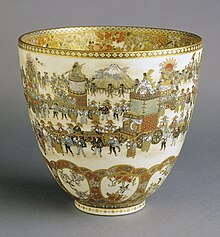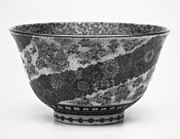Yabu Meizan
Yabu Meizan | |
|---|---|
| Born | Yabu Masashichi January 20, 1853 Nagahori, Osaka |
| Died | 1934 (aged 80–81) |
| Nationality | Japanese |
| Known for | Satsuma ware |
Yabu Meizan (Template:Lang-ja, birth name Yabu Masashichi (藪 政七),[1] January 20, 1853 – 1934) was a Japanese artist and workshop owner known for painting on porcelain. His studio produced high-end Satsuma ware, primarily for the export market. That term was originally coined for artistic painted porcelain from the Satsuma Province. Eventually it expanded to include low-quality porcelain that was mass-produced for export, whereas Meizan was one of the artists who continued the tradition of high artistic quality while also successfully exporting.[2][3] He is regarded as the "prince" of this medium[3][4] and today his works are sought after by collectors.[3]
Biography

Yabu Meizan was born on January 20, 1853 in Nagahori, Osaka.[1] In 1880 he opened his workshop in Osaka, employing and training artists.[5][2] Wares were brought from the kiln of Chin Jukan in Satsuma Province to Osaka to be decorated.[6] The American art museum founder Charles Parsons recounts a visit to Meizan's workshop in his book Notes of a Trip around the World in 1894 and 1895.[7]
"He is very celebrated. He had 17 men and boys at work, all decorating. He makes the designs and watches them carefully in executing the work. Some are very wonderful workers. All is order, neatness and silence, no words spoken."
Meizan actively marketed his work internationally as well as domestically, taking an active role in organising the presentation of Japanese wares at world's fairs. This led to acclaim as well as sales.[6] His success inspired another workshop to use his name and imitate his style, without matching his subtlety or detail.[8] His career declined during World War I as the war and economic turmoil made it difficult to run an export business.[8] Japanese art was also falling out of favour with American and European buyers, who gradually turned to China.[8]
Style
Meizan's works are characterised by minute decoration applied using copper plate designs. These engraved copper plates were used to print the designs on paper, which would then be cut to provide stencils for painting on vases or plates.[6] His decorations used Chinese and Buddhist subjects until the 1890s, when he adopted more Japanese symbolism, such as fishermen or fighting samurai.[4][6] He would draw from or copy popular prints by artists including Hiroshige.[6] Over the course of his career, the designs included more and more detail. A single work might depict thousands or flowers or butterflies, or hundreds of people in a procession.[6] Towards the end of his career he took a different approach, covering whole vases in a single motif.[9] This new artistic direction, which may have been inspired by critics' opinions, was a commercial failure at the time; buyers much preferred the crowded style.[8]
Exhibitions
From 1885 to 1916, Meizan displayed his art works at a number of national exhibitions and world's fairs, winning multiple medals.[6] These included the Fourth Kyoto Exhibition of 1885 (where he won a bronze medal),[4][6] the Paris Exposition Universelle of 1899 and again in 1900, the Louisiana Purchase Exhibition of 1904[7] and the London Japan–British Exhibition of 1910.[4] For the Louisiana Purchase Exhibition, Meizan was appointed as secretary of the Japan Exhibits Association, organising the arrangement and decoration of the hall.[6] His final international exhibition was the 1915 Panama–Pacific International Exposition in San Francisco.[8]
Outside of Japan a large collection of his art works form part of the Khalili Collection of Japanese Art.[10] The Walters Art Museum and the Metropolitan Museum of Art also hold pieces. Works by Meizan were included in exhibitions drawn from the Khalili Collections at the National Museum of Wales, Cardiff, in 1994 and 1995,[11] in the Wilmington Arts Centre, Delaware, in 1999,[12] Portland Art Museum in 2002,[13] and in the Van Gogh Museum, Amsterdam, in 2006.[14]
Gallery
-
Bowl, late 19th century
-
Vase, circa 1890
-
Bowl with a multitude of women, circa 1904
-
Bowl, circa 1910
References
- ^ a b "Yabu, Meizan, 1853-1934". Library of Congress Name Authority File. Library of Congress. Retrieved April 28, 2020.
- ^ a b Checkland, Olive (2003). Japan and Britain after 1859 : creating cultural bridges. Routledge Curzon. p. 45. ISBN 9781135786199. Retrieved April 28, 2020.
- ^ a b c "Gilding The Green Houses: A short history of Satsuma ware". www.bonhams.com. Retrieved April 28, 2020.
- ^ a b c d "Yabu Meizan (1853-1934) A large and highly important Satsuma presentation vase Meiji era (1868-1912), early 20th century". www.bonhams.com. September 13, 2017. Retrieved April 28, 2020.
- ^ Earle 1999, p. 117.
- ^ a b c d e f g h i Earle 1999, p. 118.
- ^ a b Launius 2020
- ^ a b c d e Earle 1999, p. 119.
- ^ Earle 1999, pp. 118–119.
- ^ "Meiji No Takara - Treasures of Imperial Japan; Ceramics Part Two: Earthenware". Khalili Collections. Retrieved April 30, 2020.
- ^ "Treasures of Imperial Japan, Ceramics from the Khalili Collection - National Museum of Wales, Cardiff". Khalili Collections. October 25, 1994. Retrieved April 28, 2020.
- ^ Earle 1999, pp. 120–139
- ^ "Splendors of Imperial Japan, Arts of the Meiji Period from the Khalili Collection". Khalili Collections. Retrieved April 28, 2020.
- ^ "Wonders of Imperial Japan, Meiji art from the Khalili Collection". Khalili Collections. Retrieved April 28, 2020.
Sources
- Earle, Joe (1999). Splendors of Meiji : treasures of imperial Japan : masterpieces from the Khalili Collection. St. Petersburg, Fla.: Broughton International Inc. ISBN 1874780137. OCLC 42476594.
- Launius, John (2020). The Life and Times of Missouri's Charles Parsons : Between Art and War. Arcadia Publishing Inc. ISBN 9781439669075.
Further reading
- Tsuyoshi, Yamazaki. "Yabu Meizan". In Impey, Oliver; Fairley, Malcolm (eds.). Meiji No Takara: Treasures of Imperial Japan : ceramics from the Khalili Collection. Kibo Foundation. ISBN 978-1-874780-06-9.




